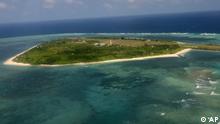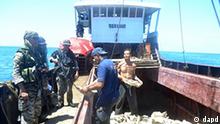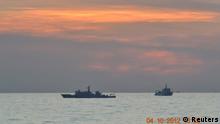
The tension in the South China Sea has escalated since the start
of the 21st century, as neighboring states vie to protect their
strategic and economic interests, but what are they really fighting for?
Its geopolitical location, an abundance of fish and huge gas and oil
reserves make the South China Sea particularly attractive to the 10
states that all lay claim to parts of it - China, Taiwan, the
Philippines, Malaysia, Brunei, Vietnam, Indonesia, Singapore, Thailand
and Cambodia.
There are also hundreds of islands and reefs in the South China Sea, which the Vietnamese call the East Sea. The Paracel Islands (known as the Xisha in China and the Hoang Sa in Vietnam), the Spratly Islands (known as the Nansha Qundao in China, the Truong Sa in Vietnam and the Kapuluan ng Kalayaan in the Philippines) are the most important disputed island groups.
The sea is also important to the rest of the world as it connects Europe, Africa, the Middle East and South Asia with East Asia and at least one third of global shipping transits through its waters.
 The Spratly Islands are a key source of tension
The Spratly Islands are a key source of tension
Almost all of China's oil exports arrive via the South China Sea and
nearly all of China's exports to Europe and Africa go in the opposite
direction.
"In strategic and military terms, the South China Sea is in a key position that enables control not only over South East Asia but over the wider realm of South and East Asia too," Gerhard Will from the German Institute for International and Security Affairs in Berlin told DW.
Fish in abundance
The South China Sea is also home to an abundance of fish. According to the International Crisis Group, 10 percent of the annual global fish yield hails from this huge body of water. However, the fisheries are at risk from over-fishing and pollution.
More and more, fishermen are being forced out into deeper waters to make a living but here they sometimes clash with maritime patrol forces protecting their national interests.
Fishermen have been arrested, their nets damaged and their boats confiscated by the security forces of other countries. Such incidents have increased in recent years.
 Fishermen have fallen victim to international political disputes
Fishermen have fallen victim to international political disputes
Not only is fish an important source of protein for the population, it
is often an important branch of the economy. In 2010, the fishing
industry made up 7 percent of Vietnam's GDP. In the Philippines, some
1.5 million people earn their living from fishing.
Rich in gas and oil
However, it is the unknown riches of gas and oil that are creating most of the tension over the South China Sea, especially as the energy needs of China and Southeast Asian nations grow as their economies boom.
"The deep waters have not yet been explored. Companies are reluctant because of the border disputes," Hans Georg Babies from the German Mineral Resources Agency told DW.
Estimates for the amount of oil range from four to 30 billion tons. The latter figure would be equivalent to all of Saudi Arabia's oil reserves.
However, Babies warned against making such wild guesses. He said that certain explorations made by the US in the 1990s in certain parts of the South China Sea had only been able to confirm the existence of about two billion tons of oil.
Gerhard Will explained that wild speculation was one of the main reasons for the current spats in the region. He said it was problematic that the estimates were so “imprecise” and the expectations so "high."
 Surveillance ships are sent out to protect national interests
Surveillance ships are sent out to protect national interests
"If there were clarity about how many resources there actually are in
the region, a joint resource management program could be developed," he
said.
In view of the current climate, observers do not think a joint solution will be agreed upon in the near future.
The rival states have been boosting their navies. China has built an underground submarine base on the southernmost tip of Hainan island, whereas Vietnam has been buying frigates and gunboats from Russia, and the Philippines plan to buy submarines from South Korea.
Nonetheless, despite such activity and the aggressive rhetoric, analysts do not believe the tension over the South China Sea will lead to serious military conflict as the wider implications would be too severe.
There are also hundreds of islands and reefs in the South China Sea, which the Vietnamese call the East Sea. The Paracel Islands (known as the Xisha in China and the Hoang Sa in Vietnam), the Spratly Islands (known as the Nansha Qundao in China, the Truong Sa in Vietnam and the Kapuluan ng Kalayaan in the Philippines) are the most important disputed island groups.
The sea is also important to the rest of the world as it connects Europe, Africa, the Middle East and South Asia with East Asia and at least one third of global shipping transits through its waters.
 The Spratly Islands are a key source of tension
The Spratly Islands are a key source of tension"In strategic and military terms, the South China Sea is in a key position that enables control not only over South East Asia but over the wider realm of South and East Asia too," Gerhard Will from the German Institute for International and Security Affairs in Berlin told DW.
Fish in abundance
The South China Sea is also home to an abundance of fish. According to the International Crisis Group, 10 percent of the annual global fish yield hails from this huge body of water. However, the fisheries are at risk from over-fishing and pollution.
More and more, fishermen are being forced out into deeper waters to make a living but here they sometimes clash with maritime patrol forces protecting their national interests.
Fishermen have been arrested, their nets damaged and their boats confiscated by the security forces of other countries. Such incidents have increased in recent years.
 Fishermen have fallen victim to international political disputes
Fishermen have fallen victim to international political disputesRich in gas and oil
However, it is the unknown riches of gas and oil that are creating most of the tension over the South China Sea, especially as the energy needs of China and Southeast Asian nations grow as their economies boom.
"The deep waters have not yet been explored. Companies are reluctant because of the border disputes," Hans Georg Babies from the German Mineral Resources Agency told DW.
Estimates for the amount of oil range from four to 30 billion tons. The latter figure would be equivalent to all of Saudi Arabia's oil reserves.
However, Babies warned against making such wild guesses. He said that certain explorations made by the US in the 1990s in certain parts of the South China Sea had only been able to confirm the existence of about two billion tons of oil.
Gerhard Will explained that wild speculation was one of the main reasons for the current spats in the region. He said it was problematic that the estimates were so “imprecise” and the expectations so "high."
 Surveillance ships are sent out to protect national interests
Surveillance ships are sent out to protect national interestsIn view of the current climate, observers do not think a joint solution will be agreed upon in the near future.
The rival states have been boosting their navies. China has built an underground submarine base on the southernmost tip of Hainan island, whereas Vietnam has been buying frigates and gunboats from Russia, and the Philippines plan to buy submarines from South Korea.
Nonetheless, despite such activity and the aggressive rhetoric, analysts do not believe the tension over the South China Sea will lead to serious military conflict as the wider implications would be too severe.
日 本 首 相 野 田 佳 彥 表 示 , 在 領 土 問 題 上 絕 不 退 讓 。
野 田 出 席 國 會 眾 議 院 一 個 委 員 會 時 表 示 , 今 後 將 進 一 步 強 化 對 領 海 和 邊 境 島 嶼 的 警 備 , 並 利 用 一 切 國 際 場 合 , 表 明 日 本 的 立 場 。
出 席 同 一 委 員 會 的 外 相 玄 葉 光 一 郎 亦 強 調 , 政 府 在 主 權 問 題 不 會 讓 步 , 但 亦 擔 心 與 中 國 產 生 誤 解 , 損 害 兩 國 關 係 。 他 指 中 國 有 多 個 海 洋 管 理 機 構 , 期 望 兩 國 成 立 專 門 的 對 話 窗 口 , 協 調 相 關 海 洋 問 題 。
Vietnam demanded Taiwan
“immediately cancel” a live-fire drill on islands it claims as
its own, according to a statement on the Ministry of Foreign
Affairs website today.
Taiwan plans to stage the exercise on Taiping Island, in
the disputed Spratly island chain in the South China Sea, next
month, the China Post reported Aug. 21. The action “severely violates Vietnam’s sovereignty, threatens peace, stability, security, marine safety, causes tensions and complicates the situation in the East Sea,”, Ministry spokesman Luong Thanh Nghi said in the statement, using the Vietnamese term for the South China Sea.
日稱考慮外交格調不再與韓殭持親筆信問題
日韓爭島又一章╱退野田筆親抗議信 南韓反吃閉門羹
針對李明博登上「竹島」並公開要求日本天皇道歉一事,野田十七日透過正式外交管道,寄給李明博一封親筆信表達遺憾之意,並敦促雙方將「竹島」問題交付國際法庭仲裁。南韓經過多日內部商討後,二十三日宣布退回該封信函。
讀 賣新聞報導,南韓退回信件的理由,包括李明博訪問的島嶼是「獨島」,而非野田所稱的「竹島」,信中的指控「與事實不符」,既然有違事實,當然不能自相矛盾 收下信函或回信。南韓外交通商部發言人趙泰永二十三日表示,回信恐將變成一個先例,讓外界誤以為兩國領導人之間有島嶼問題存在。
日本方面則認為,不管信函內容如何,退回邦交國元首的親筆信,不僅失禮也有違外交慣例。日方高層二十三日獲知消息後相當惱火,官房長官藤村修聲稱此舉「十分失禮」。外相玄葉光一郎也說,此舉「按外交慣例不可能發生」。
野田二十三日在眾議院表示,李明博要日皇致歉的發言「非常脫離常識」,要求韓方致歉並撤回發言。玄葉二十二日更在國會答詢時撂下重話,聲稱南韓「非法佔據竹島」。這是民主黨政府二○○九年上台以來,首次使用「非法佔據」的強烈措辭。
南韓改採寄掛號信退回
為反制南韓退信,日本外務省二十三日以韓方未正式預約為由,拒絕負責歸還信函的南韓駐日使館人員進入。南韓因此改採掛號郵寄方式退回該信函。
另 外,美國白宮國家安全會議亞太事務主任羅素(Daniel R Russel)和助理國務卿坎貝爾,二十二日在華府與日本外務省亞洲大洋洲局局長杉山晉輔舉行會談時,重申「釣魚台為美日安保條約的適用對象」。對於「竹 島」的紛爭,,美方表示,領土紛爭一般應依循國際法和平解決。
竹島の大統領直筆碑、土台部分撤去へ 無許可設置が判明
 |
日韓が領有権を争っている竹島(韓国名・独島〈トクト〉)に建てられた李明博(イ・ミョンバク)大統領直筆の石碑の土台が、韓国政府の許可を受けていない建造物だったことが分かり、碑の周りの土台部分だけが撤去されることになった。
碑は、地元の慶尚北道が政府の許可を得て設置し、李大統領の直筆のハングルで「独島」「大韓民国」などと刻まれ、19日に除幕された。
碑は国旗掲揚台などがある大きな円形の土台の一角に建てられたが、昨年8月に土台を造った際、竹島での建設に必要な文化財庁の許可を受けていなかったことが発覚。道などが関係機関と協議し、「違法」な土台部分はいったん撤去せざるを得ないとの結論に達したという。
碑自体は設置許可を得ており、そのまま残ることになるとしている。(ソウル=貝瀬秋彦)
****

日本知名民族主義者、東京都知事石原慎太郎(Shintaro Ishihara)說﹐我們必須在這些島嶼上建立電信基地、港口和氣象站。石原慎太郎曾提出由東京都購買爭議島嶼﹐這一飽受爭議的提議已經發展成今年夏天最激烈的外交爭鬥之一。
這名人氣頗高、已任職四個任期的東京都知事最近在接受採訪時說﹐沒有這些東西﹐我們就無法對爭議島嶼實施有效的控制。
石原慎太郎的計劃將讓日本政府陷入尷尬境地﹐日本正努力緩和這些島嶼引發的緊張關係。中日爭議島嶼位於沖繩和台灣之間的海域﹐在日本被稱作尖閣列島(Senkaku)﹐在中國被稱作釣魚島。這些島嶼目前由日本控制﹐但中國大陸和台灣都聲稱對其擁有主權。
儘管這些島嶼的主權歸屬問題時不時成為中日兩國爭議的焦點(最近一次是在2010年)﹐但今年4月以前﹐這一問題已經淡出人們的視野。今年4月﹐石原慎太郎稱東京都正在就從一個日本私人島主那裡購島進行談判﹐並開始為購島進行籌款。
石原慎太郎說﹐截至8月中旬﹐東京都已經募集了大約15億日圓(約合1,900萬美元)。
石原慎太郎的舉動引發了日本政府的介入﹐日本政府表示願意出面購島。中國表示﹐不允許任何人購買這些島嶼。
過去幾週﹐來自香港和日本的活動人士在未授權的情況下登上了這些島嶼﹐競相宣示主權﹐這引發了兩國言辭激烈的表態﹐中國還發生了反日示威活動。
日本政府週一試圖阻止石原慎太郎採取進一步行動﹐拒絕了東京都登島勘測島嶼價值的請求。不過﹐東京都仍然打算從海上對島嶼進行勘測。石原慎太郎上週五說﹐他本人將帶領第二支勘測隊於10月份登島﹐無論是否獲得允許。
石原慎太郎在採訪中說﹐他之所以想要登上爭議島嶼是出於對中國的擔心﹔中國正在不斷增強其海上力量﹐近年來在太平洋地區提出了越來越強硬的領土要求。
為支持日本的主張﹐石原慎太郎提議由東京都或日本中央政府在爭議島嶼上建設各種設施﹐包括一個漁港、一個氣象站和一個無線電信號基站。目前這一爭議島嶼無人居住。

他說﹐在最壞的情況下﹐我們可能需要在那裡部署自衛隊。自衛隊是日本的軍隊﹐根據憲法規定﹐自衛隊的活動僅限於防御。
對於如果不因爭議島嶼發生口角中日關係將會改善的看法﹐石原慎太郎表示不屑一顧。他指出﹐幾週前登上爭議島嶼的香港活動人士朝著試圖阻止他們靠近的一艘日本海上保安廳船只扔磚頭。
石原慎太郎說﹐人們說﹐如果石原慎太郎買下爭議島嶼﹐誰知道會發生什麼事﹔但如果日本中央政府買下這些島嶼﹐政府什麼事都不會做﹐所以不會與中國發生任何摩擦。石原慎太郎說﹐如果情況繼續像這樣發展下去﹐摩擦是會出現的。
在整個採訪期間﹐在談到中國時﹐石原慎太郎除了使用日文中的標準稱謂“中國”(Chugoku)外﹐還常常使用“支那”(Shina)這一日本佔領中國大片國土期間使用的一個具有侮辱意味的詞匯。
不過﹐石原慎太郎對另外一組爭議島嶼的態度卻遠沒有這麼激進。這組島嶼被稱為“利揚庫爾巖”(Liancourt Rocks)﹐其主權歸屬是目前日本與韓國關係緊張的原因之一。
在韓國總統李明博(Lee Myung-bak)訪問了利揚庫爾巖後﹐8月初日韓緊張關係開始升溫。這組島嶼目前由韓國控制﹐在韓國被稱為“獨島”(Dokdo)﹐在日本被稱為“竹島”(Takeshima)。
此事令日韓之間爆發了一場外交戰﹐兩國雙雙發表激烈言辭、取消雙邊會晤﹐日本還威脅要將此事提交到國際法庭。目前兩國之間的外交戰仍在升級。
石原慎太郎說﹐韓國對爭議島嶼的控制可以追隨到二戰日本戰敗後的時期﹐如今這一事實已經很難改變。石原慎太郎說﹐時間過去太久了﹐儘管非常遺憾﹐但現在基本已成定局。
Phred Dvorak / Toko Sekiguchi
碑は、地元の慶尚北道が政府の許可を得て設置し、李大統領の直筆のハングルで「独島」「大韓民国」などと刻まれ、19日に除幕された。
碑は国旗掲揚台などがある大きな円形の土台の一角に建てられたが、昨年8月に土台を造った際、竹島での建設に必要な文化財庁の許可を受けていなかったことが発覚。道などが関係機関と協議し、「違法」な土台部分はいったん撤去せざるを得ないとの結論に達したという。
碑自体は設置許可を得ており、そのまま残ることになるとしている。(ソウル=貝瀬秋彦)
****
在
日本政府努力平息中日因兩國間一系列島嶼的主權歸屬問題發生的爭執之際﹐導致目前兩國緊張關係全面升溫的始作俑者卻絲毫沒有罷休的跡象。
Agence France-Presse/Getty Images
東京都知事石原慎太郎。
這名人氣頗高、已任職四個任期的東京都知事最近在接受採訪時說﹐沒有這些東西﹐我們就無法對爭議島嶼實施有效的控制。
石原慎太郎的計劃將讓日本政府陷入尷尬境地﹐日本正努力緩和這些島嶼引發的緊張關係。中日爭議島嶼位於沖繩和台灣之間的海域﹐在日本被稱作尖閣列島(Senkaku)﹐在中國被稱作釣魚島。這些島嶼目前由日本控制﹐但中國大陸和台灣都聲稱對其擁有主權。
儘管這些島嶼的主權歸屬問題時不時成為中日兩國爭議的焦點(最近一次是在2010年)﹐但今年4月以前﹐這一問題已經淡出人們的視野。今年4月﹐石原慎太郎稱東京都正在就從一個日本私人島主那裡購島進行談判﹐並開始為購島進行籌款。
石原慎太郎說﹐截至8月中旬﹐東京都已經募集了大約15億日圓(約合1,900萬美元)。
石原慎太郎的舉動引發了日本政府的介入﹐日本政府表示願意出面購島。中國表示﹐不允許任何人購買這些島嶼。
過去幾週﹐來自香港和日本的活動人士在未授權的情況下登上了這些島嶼﹐競相宣示主權﹐這引發了兩國言辭激烈的表態﹐中國還發生了反日示威活動。
日本政府週一試圖阻止石原慎太郎採取進一步行動﹐拒絕了東京都登島勘測島嶼價值的請求。不過﹐東京都仍然打算從海上對島嶼進行勘測。石原慎太郎上週五說﹐他本人將帶領第二支勘測隊於10月份登島﹐無論是否獲得允許。
石原慎太郎在採訪中說﹐他之所以想要登上爭議島嶼是出於對中國的擔心﹔中國正在不斷增強其海上力量﹐近年來在太平洋地區提出了越來越強硬的領土要求。
為支持日本的主張﹐石原慎太郎提議由東京都或日本中央政府在爭議島嶼上建設各種設施﹐包括一個漁港、一個氣象站和一個無線電信號基站。目前這一爭議島嶼無人居住。

Associated Press
8月15日,一艘載有香港保釣人士前往中日爭議島嶼的船隻被日本海上保安廳的巡邏艇包圍。
對於如果不因爭議島嶼發生口角中日關係將會改善的看法﹐石原慎太郎表示不屑一顧。他指出﹐幾週前登上爭議島嶼的香港活動人士朝著試圖阻止他們靠近的一艘日本海上保安廳船只扔磚頭。
石原慎太郎說﹐人們說﹐如果石原慎太郎買下爭議島嶼﹐誰知道會發生什麼事﹔但如果日本中央政府買下這些島嶼﹐政府什麼事都不會做﹐所以不會與中國發生任何摩擦。石原慎太郎說﹐如果情況繼續像這樣發展下去﹐摩擦是會出現的。
在整個採訪期間﹐在談到中國時﹐石原慎太郎除了使用日文中的標準稱謂“中國”(Chugoku)外﹐還常常使用“支那”(Shina)這一日本佔領中國大片國土期間使用的一個具有侮辱意味的詞匯。
不過﹐石原慎太郎對另外一組爭議島嶼的態度卻遠沒有這麼激進。這組島嶼被稱為“利揚庫爾巖”(Liancourt Rocks)﹐其主權歸屬是目前日本與韓國關係緊張的原因之一。
在韓國總統李明博(Lee Myung-bak)訪問了利揚庫爾巖後﹐8月初日韓緊張關係開始升溫。這組島嶼目前由韓國控制﹐在韓國被稱為“獨島”(Dokdo)﹐在日本被稱為“竹島”(Takeshima)。
此事令日韓之間爆發了一場外交戰﹐兩國雙雙發表激烈言辭、取消雙邊會晤﹐日本還威脅要將此事提交到國際法庭。目前兩國之間的外交戰仍在升級。
石原慎太郎說﹐韓國對爭議島嶼的控制可以追隨到二戰日本戰敗後的時期﹐如今這一事實已經很難改變。石原慎太郎說﹐時間過去太久了﹐儘管非常遺憾﹐但現在基本已成定局。
Phred Dvorak / Toko Sekiguchi
沒有留言:
張貼留言